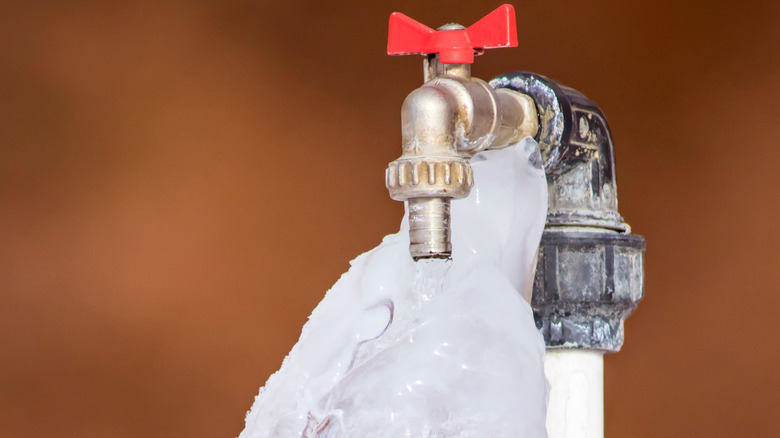Crucial Tips to Prevent Frozen Plumbing in Cold Weather
Crucial Tips to Prevent Frozen Plumbing in Cold Weather
Blog Article
They are making several great points regarding Helpful Tips to Prevent Frozen Pipes this Winter in general in this article followed below.

Cold weather can damage your plumbing, particularly by freezing pipes. Below's exactly how to avoid it from occurring and what to do if it does.
Introduction
As temperature levels decrease, the risk of icy pipelines increases, possibly leading to pricey repair services and water damages. Understanding how to avoid frozen pipes is important for homeowners in chilly climates.
Recognizing Icy Pipes
What creates pipelines to freeze?
Pipelines ice up when exposed to temperatures listed below 32 ° F (0 ° C) for extended durations. As water inside the pipes ices up, it expands, putting pressure on the pipeline walls and potentially creating them to break.
Risks and problems
Frozen pipelines can bring about water disruptions, residential property damages, and expensive repairs. Burst pipes can flood homes and cause comprehensive architectural damages.
Indications of Frozen Pipes
Determining icy pipes early can prevent them from breaking.
Just how to recognize icy pipes
Search for lowered water circulation from faucets, uncommon odors or sounds from pipelines, and visible frost on revealed pipes.
Prevention Tips
Protecting vulnerable pipelines
Cover pipes in insulation sleeves or use warmth tape to shield them from freezing temperature levels. Concentrate on pipelines in unheated or external locations of the home.
Heating techniques
Keep indoor rooms sufficiently warmed, specifically areas with pipes. Open up cupboard doors to enable warm air to distribute around pipelines under sinks.
Securing Exterior Pipes
Garden hose pipes and outdoor faucets
Disconnect and drain pipes garden hose pipes before winter months. Mount frost-proof spigots or cover outside faucets with protected caps.
What to Do If Your Pipelines Freeze
Immediate activities to take
If you think icy pipes, keep taps available to eliminate pressure as the ice melts. Utilize a hairdryer or towels taken in hot water to thaw pipes slowly.
Long-Term Solutions
Structural modifications
Think about rerouting pipelines far from exterior walls or unheated areas. Add added insulation to attic rooms, basements, and crawl spaces.
Upgrading insulation
Invest in high-grade insulation for pipelines, attic rooms, and wall surfaces. Appropriate insulation assists keep consistent temperatures and lowers the danger of icy pipes.
Final thought
Protecting against frozen pipes needs aggressive procedures and fast feedbacks. By understanding the causes, indications, and preventive measures, house owners can shield their pipes throughout winter.
5 Ways to Prevent Frozen Pipes
Drain Outdoor Faucets and Disconnect Hoses
First, close the shut-off valve that controls the flow of water in the pipe to your outdoor faucet. Then, head outside to disconnect and drain your hose and open the outdoor faucet to allow the water to completely drain out of the line. Turn off the faucet when done. Finally, head back to the shut-off valve and drain the remaining water inside the pipe into a bucket or container. Additionally, if you have a home irrigation system, you should consider hiring an expert to clear the system of water each year.
Insulate Pipes
One of the best and most cost-effective methods for preventing frozen water pipes is to wrap your pipes with insulation. This is especially important for areas in your home that aren’t exposed to heat, such as an attic. We suggest using foam sleeves, which can typically be found at your local hardware store.
Keep Heat Running at 65
Your pipes are located inside your walls, and the temperature there is much colder than the rest of the house. To prevent your pipes from freezing, The Insurance Information Institute suggests that you keep your home heated to at least 65 degrees, even when traveling. You may want to invest in smart devices that can keep an eye on the temperature in your home while you’re away.
Leave Water Dripping
Moving water — even a small trickle — can prevent ice from forming inside your pipes. When freezing temps are imminent, start a drip of water from all faucets that serve exposed pipes. Leaving a few faucets running will also help relieve pressure inside the pipes and help prevent a rupture if the water inside freezes.
Open Cupboard Doors
Warm your kitchen and bathroom pipes by opening cupboards and vanities. You should also leave your interior doors ajar to help warm air circulate evenly throughout your home.

We hope you enjoyed our section on How to Prevent Your Pipes From Freezing. Thank you for taking the time to read our blog post. If you enjoyed reading our page please don't forget to share it. We love your readership.
Further Details Report this page